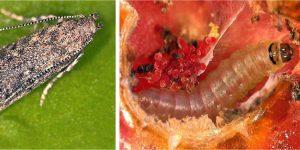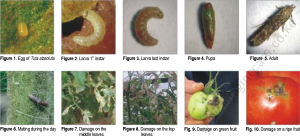Tuta absoluta (Lepidoptera: Gelechiidae) is a highly destructive insect pest to tomato plants and fruit and is also reported to infest other plants in the Solanaceae family. It also occurs on weeds of the Solanaceae family (Solanum nigrum, Datura spp.). Recently Tuta absoluta considered to be a serious threat to tomato production in Kenya.
Tuta absoluta is a very challenging pest to control. Effectiveness of chemical control is limited due to insect’s nature of damage as well as its rapid capability of development of insecticide resistant strains.
Damage caused
The larvae of Tuta absoluta mine the leaves producing large galleries and burrow into the fruit, causing a substantial loss of tomato production in green houses and in open field. The larvae feed on mesophyll tissues and make irregular mine on leaf surface. Most distinctive symptoms are the blotch-shaped mines in the leaves.
Inside these mines both the caterpillars and their dark frass can be found. Mining damage to the plant causes its malformation. Damage to fruit allows fungal diseases to enter, leading to rotting fruit before or after harvest. Damage by Tuta absoluta result to 50%-100% yield reduction of tomato. Severely attacked tomato fruits lose their commercial value.
Eggs
Eggs are Small cylindrical, creamy white to yellow 0.35 mm long. Egg hatching takes place 4-6 days after egg lying.
Larvae
The Larvae is cream in color with characteristic dark head. Four larval instars develop. Larvae do not enter diapause when food is available. The larvae become greenish to light pink in second to fourth instars. Larval period is most damaging period which completed within 12-15 days.
Pupa
They are brown in color. Pupation may take place in the soil, on the leaf surface or within mines. This stage does not cause any damage to the crop. The stage is completed in 10 days
Adult
Adults are nocturnal and hide between leaves during the day time. Adults are 5-7 mm long and with a wingspan of 8-10 mm Adult females lay eggs on host plants and. mature female could lay up to 260 eggs before completing life cycle.
Tuta absoluta produces about 10–12 generations per year. The total live cycle is completed within 30-35 days.
Management of Tuta absoluta
Chemical control
Chemical control has been the main control measure used against Tuta absoluta since it was reported in the country. There are several registered products for the control of this pest. Despite the numerous pesticides registered to manage Tuta absoluta, most of them are of low to moderate effectiveness due to the cryptic nature of the larvae and the high biotic potential of the insect. In addition, several cases of insecticide resistance have been reported.
Chemical Recommendation
ESCORT 10ml/20l + INTEGRA 3 ml/20l or,
ALONZE 3ml/20l +INTEGRA 3ml/20l
Biological Control
Several biocontrol agents are used to control the tomato leaf miner in open field and greenhouse tomato cultivation. The most common predator against T. absoluta is the mirid bugs. Bacillus thuringiensis (BT)-based insecticide formulations have been used to control T. absoluta in its native and invaded regions. The limitation of biological control is that it’s slow and is not efficient when populations are very high.
Cultural Control
Ploughing, manuring, irrigation, crop rotation, solarisation, and the elimination of symptomatic leaves and destruction of infested tomato plants have all been used to control this pest. The removal of alternative reservoir hosts such as nightshades is strongly recommended before and during the cropping cycle.




















